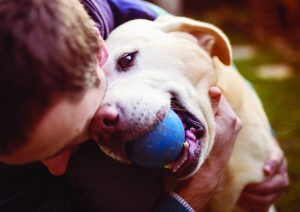by Lori Carman, VSPDT, Dream Dogs
The American Veterinary Medical Association defines the human-animal bond as “a mutually beneficial and dynamic relationship between people and animals that is influenced by behaviors that are essential to the health and well-being of both.” So, what are the behaviors in question? Being a responsible caretaker is at the foundation, of course, and includes providing food, water, shelter, and safety, as well as medical care when needed. But aside from that, what influences a person’s relationship with her dog? What takes it from good to great? In the human world, psychologist John Gottman spent four decades studying couples to find out what makes marriages happy and lasting. His major takeaway was that a deep sense of connection and trust is built between couples that make many “bids”—verbal or nonverbal requests for attention and connection—and offer positive responses to those bids.
Positive reinforcement training shows us that the same principles apply to dog-human relationship building. If you like something and reward it, not only will it be more likely to happen again, but everyone involved in the interaction feels better about each other. More connected, more trusting. The one caveat is that it’s important not to reinforce behavior we don’t like (with any kind of attention, positive or negative) and that we should therefore ignore whining, jumping up, nudging, and so on. Beyond that, though, any time spent with dogs offers opportunities to extend and respond to bids.
For example, just looking at a dog with a happy or playful expression qualifies as positive attention and therefore a bid for connection. Ditto saying “what a good dog you are…” in a soft voice for no particular reason. The same goes for reaching over to a dog lying quietly on or beside the couch to scratch a belly or neck, depending on the dog’s preference. Have three minutes to spare? Play a quick game. Get out a treat and practice a fun trick. What’s the lesson? Never think you’re spoiling your dog with these kindnesses. They are tiny investments in a lifelong, loving relationship. Every time we remember to stop to give our dogs affection and attention, we are making deposits on a richer and ever-deepening bond.

Yoga for Dogs
Like cats, dogs seem to have a built-in understanding of the healing and wellness-boosting properties of stretching. It is a priority to them and most stretch thoroughly several times a day. Yoga for dogs can be a natural extension of this stretching habit—a fun, healthful, and relaxing activity you can share with your dog, whether at a neighborhood yoga studio (some offer doga classes), with a group of friends, or in your own living room. For dogs that get into the practice, yoga can promote flexibility, increased blood circulation, and quicker recovery from strenuous walks or play sessions. And for dogs that don’t quite catch on, yoga sessions mean spending enjoyable time with you.
To explore yoga with your dog, check out some of the many videos on YouTube on the topic, or invest in a DVD or book. And if you are a yoga enthusiast already, do a little research online for inspiration on how to include your dog in your favorite workout and then get stretching.
This article appeared in the Summer 2016 issue, page 56.
Lori Wainio-Carman, VSPDT, professional dog trainer and owner of Dream Dogs, has been successfully training for over 20 years. 760-899-7272, www.dreamdogs.com, www.Positively.com



